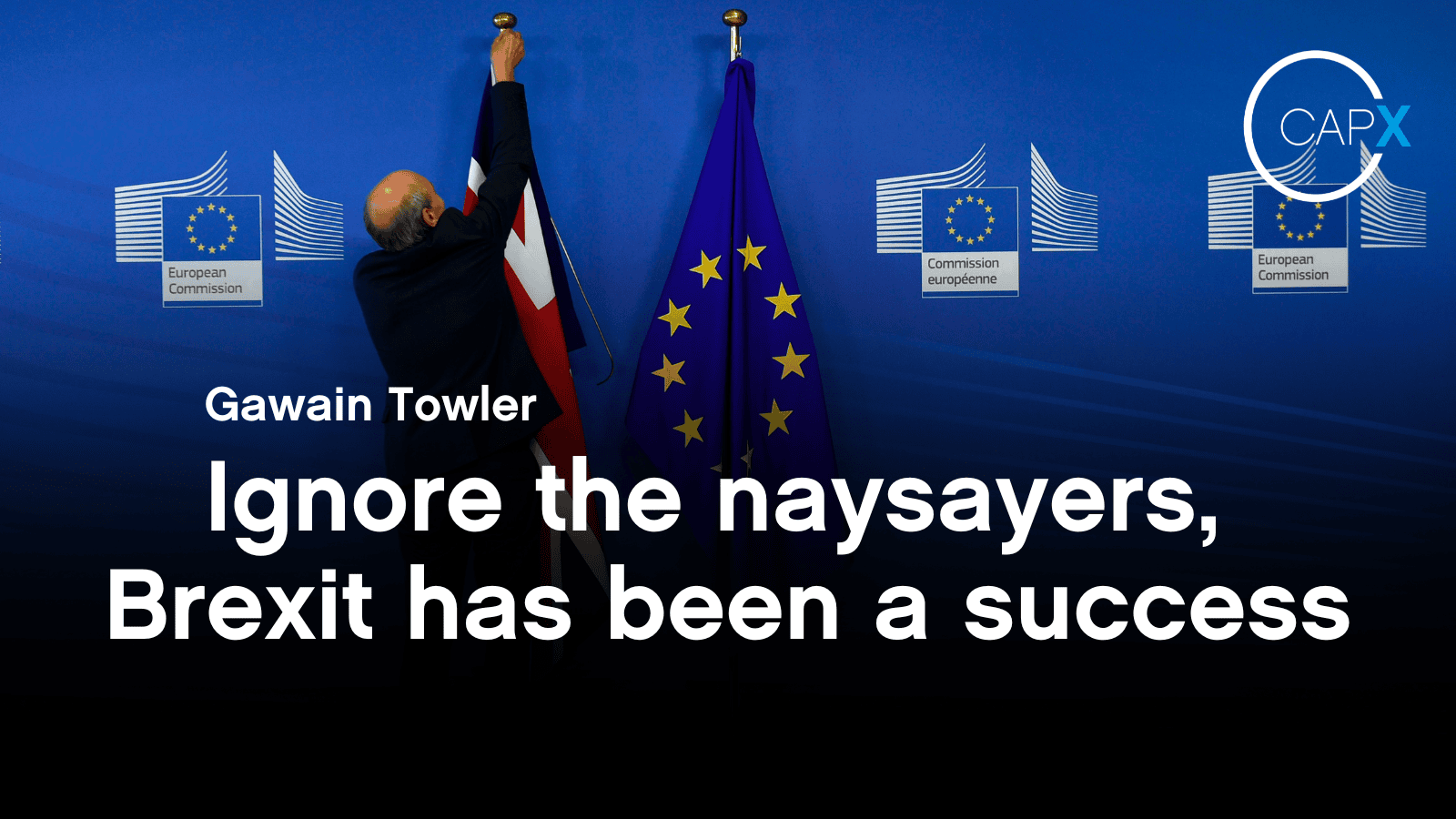Share
-
A new book dismantles the claims made by the Brexit cynics
-
Leaving the EU has supercharged trade and free markets
-
For too long, Remainiacs in academia have been allowed to hijack the debate
For years, the Remainiacs and their cheerleaders in the establishment – academe, unions, the media and celebrity circles – have relentlessly attacked Brexit as a wasteland, barren of benefits. They’ve mocked it with gimmicky books featuring blank pages, jocularly symbolising, they claim, the absence of any tangible gains.
Well-funded think tanks, like the Tony Blair Institute or UK in a Changing Europe, have pumped out report after report of anti-Brexit propaganda, often veering into outright anti-British sentiment by portraying the UK as diminished and isolated without EU shackles. Their narrative: Brexit has crippled trade, stifled free markets and doomed us to economic irrelevance. (And thus we must return to the EU’s warm embrace.)
Meanwhile, the pro-Brexit voices have gone strangely silent, or been silenced, amid a cacophony of doom-mongering. Yet, here’s the irony: even Keir Starmer’s Labour Government, despite its overt desire to ‘snuggle up’ to Brussels and foster momentum for rejoining, is quietly reaping the rewards of our independence. From slashing tariffs to forging agile trade deals, Labour inherits a freer, more dynamic economy.
Enter Gully Foyle’s ‘75 Brexit Benefits: Tangible Benefits from the UK Having Left the European Union’, published by the Bruges Group with a foreword by John Redwood. This meticulously researched tome dismantles the naysayers by cataloging concrete wins, with a laser focus on trade and free markets that should resonate deeply with CapX readers.
Foyle, writing under a pseudonym inspired by Alfred Bester’s sci-fi classic, structures the book around seven benefit categories, but it’s Section 3 (‘Brexit Means Better Trade’) and Section 5 (‘Brexit Means a Better Economy’) that shine brightest. Drawing on official data, WTO insights and real-world examples, Foyle argues Brexit has unshackled the UK from the EU’s sclerotic customs union and single market, far from the ‘free market’ Redwood debunks in his foreword as a myth. Instead, it was a protectionist fortress, laden with tariffs and barriers that favored continental giants like France and Germany while often burdening UK consumers and exporters.
Take trade deals. Inside the EU, negotiations dragged on for years, diluted to suit 27 divergent economies. Foyle highlights how post-Brexit, the UK has struck deals ‘harder, better, faster, stronger’ (Benefit 25). The Australia and New Zealand FTAs were sealed in record time, with bespoke terms like digital economy provisions absent from EU pacts. The UK’s accession to the The Comprehensive and Progressive Agreement for Trans-Pacific Partnership, (CPTPP) (Benefit 69) demonstrated independence and opened doors to the Indo-Pacific’s booming markets, where growth outpaces Europe’s stagnation. These weren’t just symbolic; they slashed tariffs on UK exports, from whisky to machinery, boosting competitiveness. Foyle notes the EU’s stalled talks with Australia contrast sharply with Britain’s nimble approach, yielding lower costs and higher profits for UK firms.
Tariff reforms emerge as a free-market triumph. Benefit 26 (‘How Low Can You Go?’) details the UK Global Tariff, which axed ‘nuisance tariffs’ below 2.5% on over 2,000 products – stone, machinery, leather – simplifying trade and reducing consumer prices. This unilateral liberalisation, impossible under EU rules, embodies Redwood’s point: out of the single market, we’ve dismantled barriers that once embedded inefficiency. Benefit 40 (‘A Stay of (Tariff) Execution’) spotlights targeted suspensions on 120+ items like flowers and chemicals, responding directly to business needs via the Department for Business and Trade. Such flexibility fosters innovation, as seen in digital trade advancements (Benefit 36) – where the UK’s world-first fully digitised shipment with Singapore cuts paperwork costs by billions.
In Section 5, Foyle ties these to broader economic vitality. Benefit 58 lifts EU commodity position limits, freeing energy traders from MiFID II caps that stifled liquidity, vital for a resilient economy. Higher salaries (Benefit 59) stem from ending free movement, tightening labour markets without EU-mandated distortions. Nuclear options (Benefit 60) allow bespoke subsidies for small modular reactors, unhindered by EU state aid rules that once blocked competitive energy policies. Foyle’s analysis of subsidies (Benefit 62) is particularly astute: the Subsidy Control Act replaces Brussels’ rigid framework with a principles-based system, minimising distortions while empowering targeted support – pure free-market pragmatism.
Critics might quibble with Foyle’s upbeat tone or selective examples, but the evidence is compelling. The book quantifies billions saved in fees (Section 1), redirectable to market-friendly initiatives like R&D tax credits. Redwood’s foreword reinforces this: Brexit spares us EU taxes on plastics and emissions, letting the UK tailor policies for growth, not bureaucracy.
In sum, ‘75 Brexit Benefits’ is a vital corrective, proving that Brexit has supercharged trade and free markets. Labour’s gains, from CPTPP dividends to tariff cuts, underscore this, even as they pine for a rejoin. For free-marketeers, it’s a manifesto: independence breeds prosperity. At 229 pages, it’s dense but rewarding, and essential reading to counter the blank-page brigade.
Me, I’ll be buying a few for some naysayer friends for Christmas. My review copy will be in the downstairs loo.
‘75 Brexit Benefits: Tangible Benefits from the UK Having Left the European Union’ is published by the Bruges Group.
– the best pieces from CapX and across the web.
CapX depends on the generosity of its readers. If you value what we do, please consider making a donation.
Columns are the author’s own opinion and do not necessarily reflect the views of CapX.
